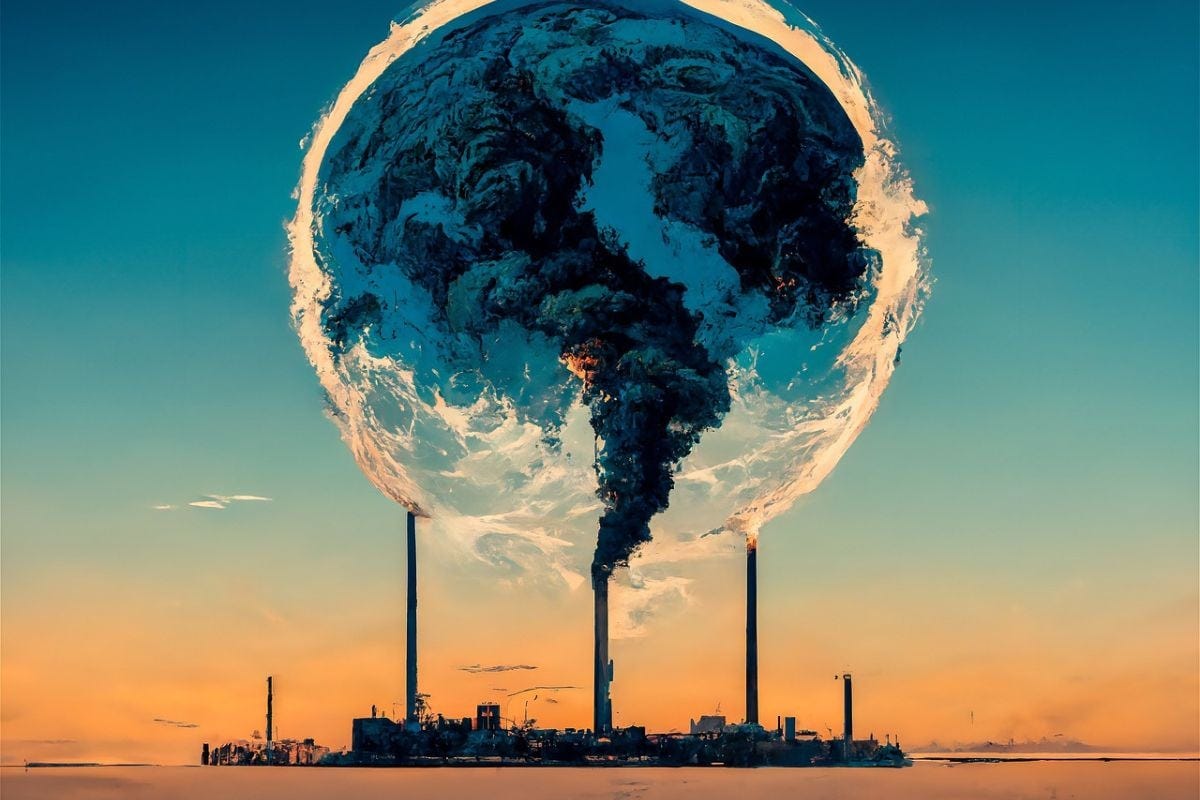By: Rafia Asim
Climate Change
Environmental change alludes to huge and enduring modifications in Earth’s environment designs over a lengthy period, normally a very long time to a long period of time. It contains changes in temperature, precipitation, wind designs, and other climatic variables that happen because of both normal cycles and human exercises. While Earth’s environment has consistently experienced vacillations throughout geographical time scales, the expression “environmental change” ordinarily alludes to the rapid and phenomenal warming saw since the late nineteenth hundred years, fundamentally ascribed to human-instigated ozone depleting material emanations (Cheung, 2020).
The primary driver of contemporary climate alteration is the increase in greenhouse gases, such as carbon dioxide (CO2), methane (CH4), and nitrous oxide (N2O), in the Earth’s atmosphere. These gases trap heat radiated from the Earth’s surface, creating a “greenhouse effect” that warms the planet. Human activities, predominantly the burning of fossil fuels for energy, industrial processes, deforestation, and agriculture, have meaningfully increased the concentration of greenhouse gases in the atmosphere since the Industrial Revolution (Shaffril, 2019).
The impact of climate change on ecosystems, weather patterns, sea levels, and human societies all over the world is extensive and profound. A portion of the noticed effects of environmental change incorporate:
Rising temperatures
Worldwide normal temperatures have been dependably expanding, prompting more successive and thrilling heat waves, as well as changes in precipitation designs (Cheung, 2020).
Melting ice caps and glaciers
The warming climate has sped up the dissolving of polar ice covers, glacial masses, and ice sheets, adding to increasing ocean heights and modifying sea flows (Auffhammer, 2018).
Changes in precipitation
Climate change is producing shifts in precipitation designs, prompting more regular and extraordinary precipitation in convinced areas, and dry spells in others.
Sea level rise
As polar ice melts and ocean water expands due to advanced temperatures, sea levels are rising, intimidating coastal communities and ecosystems.
Extreme weather events
Climate change is related to an increase in the frequency and intensity of dangerous weather events, including hurricanes, typhoons, floods, and wildfires (Auffhammer, 2018).
Disruption of ecosystems
Changes in temperature and precipitation are troublesome ecosystems, leading to shifts in species distributions, loss of biodiversity, and degradation of habitations.
Impacts on agriculture and food security
Climate change is moving crop yields, water availability, and agricultural productivity, posing dangers to global food security and livelihoods.
Tending to climate change requires purposeful endeavors at the worldwide, public, and neighborhood levels to moderate ozone-depleting material outflows, adjust to the effects of environmental change, and progress to an additional economical and strong future. This includes implementing policies to cut down on the use of fossil fuels, supporting renewable energy foundations, protecting ecosystems, and making vulnerable communities more resilient to climate change. (Baldwin, 2018).
The collective efforts and events taken by nations and international organizations to maintain peace, stability, and safety on a global scale are referred to as “international security.” It encompasses a wide range of threats, hazards, and difficulties that have the potential to disrupt the peaceful coexistence of nations and put their citizens’ well-being in jeopardy. Global security is an intricate and multi-layered idea that envelops both conventional and forward-thoughtful security subjects, including military contentions, psychological warfare, weapons expansion, digital dangers, pandemics, natural corruption, and monetary unsteadiness (Cheung, 2020).
International security
At its center, global security is tied in with shielding the power, regional respectability, and public interests of states, while furthermore advancing collaboration, exchange, and compromise to address normal security challenges. It comprises diplomatic, economic, military, and humanitarian efforts to prevent, manage, and end conflicts as well as lessen the influence of security threats on global peace and stability (Booth, 2018).
Key components of international security include:
Military security
This includes endeavors to anticipate outfitted clashes, hinder hostility, and advance demilitarization and arms regulator measures to lessen the gamble of war. Military coalitions, safeguard participation arrangements, and peacekeeping activities assume pivotal parts in keeping up with military security at the regional and worldwide levels.
Political security
International security is contingent on political stability and good governance. Strategic endeavors, discussions, and compromise components, like intervention and assertion, are utilized to address political pressures, advance exchange, and keep clashes from rising into brutality (Collins, 2022).
Economic security
Financial dependability and flourishing are necessary to worldwide security, as monetary emergencies and inequities can fuel social agitation and political flimsiness. Poverty reduction, trade liberalization, and economic development creativities all help to improve economic security and lower the likelihood of conflict and unpredictability.
Human security
Human security focuses on protecting individuals from threats to their security, well-being, and dignity, including armed conflict, terrorism, human rights abuses, and humanitarian crises. Efforts to endorse human security encompass humanitarian assistance, refugee protection, human rights advocacy, and peace-building initiatives intended to address the root causes of conflict and insecurity (Spiegeleire et al., 2017).
Environmental security
Ecological debasement, climate change, and catastrophic events present critical difficulties to global security, as they can intensify asset shortage, displacing, and struggle over land, water, and normal assets. Tending to natural security risks requires participation, economic advancement practices, and flexibility-building endeavors to relieve the effect of environmental change and protect weak populaces (Campbell, 2022).
Generally speaking, global security is a dynamic and developing impression that requires aggregate activity and participation among countries, global associations, common society entertainers, and different partners to address arising dangers and difficulties in an interconnected world. By cooperating to advance agreement, solidness, and flourishing, the global-local area can construct a more secure and safer future for all (Poushter, 2017).
Effect of climate change on international security
Conflicts over uncommon resources, displacement, and humanitarian crises could be stoked by climate change, which could exacerbate existing vulnerabilities and pose significant threats to international security. The impacts of environmental change on global security are assorted and interconnected, affecting different components of safety, including military, political, monetary, human, and ecological security. Here are a few dynamic impacts of environmental change on global security (Parry, 2017)
Resource Scarcity and Conflict
Environmental change adds to the consumption of steady assets like water, arable land, and energy, expanding rivalry and pressures over admittance to these assets. This can fuel existing struggles and possibly flash new ones, especially in areas previously confronting asset deficiency and political precariousness. For occurrence, disagreements about water privileges in the Center East and North Africa districts, exacerbated by water shortage because of environmental change, can possibly grow into clashes.
Displacement and Migration
Environmental change-prompted natural humiliation, including ocean level ascent, outrageous climate occasions, and desertification, can compel networks to relocate looking for more secure and more tenable conditions. This can quick inside removal, cross-line movement, and exile brooks, stressing host nations’ assets, intensifying social pressures, and possibly filling clashes over assets and region.
Food Insecurity and Economic Instability
Environmental change upsets rural outlines, prompting diminished crop yields, food deficiencies, and cost unpredictability. This can compound food hesitation and destitution, especially in weak districts previously wrestling with financial difficulties. Food frailty and monetary shakiness can add to social turmoil, political precariousness, and fights, as found in examples of food riots and common agitation set off by food cost spikes (Parry, 2019).
Extreme Weather Events and Humanitarian Crises
Environmental change is heightening the reappearance and seriousness of outrageous climate occasions, including typhoons, floods, dry spells, and rapidly spreading fires. These occasions can cause boundless annihilation, uprooting, and death toll, and encourage helpful emergencies that need worldwide support and coordination. Disasters caused by climate change can put a strain on humanitarian resources, exacerbate social tensions, and obstruct efforts to build peace and develop countries (Parry, 2017).
Impact on Infrastructure and Security Assets:
Environmental change offers dangers to a basic framework, including army bases, transportation organizations, and energy offices. Rising ocean levels, outrageous climate occasions, and changing natural circumstances can harm or upset the basis fundamental for public safety, compromising military preparation and reaction abilities. Environment-related dangers to the framework can likewise present difficulties to vital preparation, protection activities, and fiasco readiness endeavors (Klinsky, 2019).
Global Governance and Conflict Prevention
Environmental change difficulties the current structures of worldwide administration and global participation, requiring eased reactions to address its mind-boggling and interconnected influences. Successful environmental activity and transformation measures are fundamental for forestalling clashes, advancing peacebuilding, and reinforcing versatility to environment-related security dangers. Multilateralism, diplomacy, and international collaboration are essential for addressing climate change as a threat to collective security and for promoting maintainable development and peace (Kogo, 2021).
Climate change threatens global peace and constancy by exacerbating existing vulnerabilities, fueling conflicts, and posing significant threats to international security. Tending to the security ramifications of environmental change needs coordinated approaches that focus on environment variation, moderation, and strength-building endeavors, as well as collaboration amongst countries, worldwide associations, and shared society entertainers to address the main drivers of environment-related security dangers and advance practical and complete turn of events.
Conclusion
Taking everything into account, environmental change presents significant difficulties to global security, with broad ramifications for agreement, solidness, and human prosperity around the world. The impacts of environmental change, including asset shortage, removal, food frailty, outrageous climate occasions, and framework weaknesses, enhance existing security gambles and can possibly fuel clashes and compassionate emergencies. Tending to the security ramifications of environmental change needs deliberate endeavors at the worldwide, public, and neighborhood levels to alleviate ozone-harming substance discharges, advance environment versatility, and fortify worldwide participation and administration. By focusing on environmental activity and building versatility to environment-related security dangers, the global-local area can reasonable the dangers of argument and shakiness and encourage a safer and economic future for all.
REFERENCE
- Auffhammer, M. (2018). Quantifying economic damages from climate change. Journal of Economic Perspectives, 32(4), 33-52.
- Baldwin, D. A. (2018). The concept of security. In National and International Security (pp. 41-62). Routledge.
- Booth, K. (2018). Security and emancipation. In National and International Security (pp. 447-460). Routledge.
- Campbell, K. M., Gulledge, J., McNeill, J. R., Podesta, J., Ogden, P., Fuerth, L., … & Mix, D. (2022). Age of consequences: the foreign policy and national security implications of global climate change. Center for a New American Security.
- Cheung, H. (2020). What does Trump actually believe on climate change. BBC News, 23.
- Collins, A. (Ed.). (2022). Contemporary security studies. Oxford University Press.
- De Spiegeleire, S., Skinner, C., & Sweijs, T. (2017). The rise of populist sovereignism: What it is, where it comes from, and what it means for international security and defense. The Hague Centre for Strategic Studies.
- Klinsky, S., Roberts, T., Huq, S., Okereke, C., Newell, P., Dauvergne, P., … & Bauer, S. (2017). Why equity is fundamental in climate change policy research.
- Kogo, B. K., Kumar, L., & Koech, R. (2021). Climate change and variability in Kenya: a review of impacts on agriculture and food security. Environment, Development and Sustainability, 23(1), 23-43.
- Parry, M. L. (2019). Climate change and world agriculture. Routledge.
- Poushter, J., & Manevich, D. (2017). Globally, people point to ISIS and climate change as leading security threats. Pew Research Center, 1.
- Shaffril, H. A. M., Samah, A. A., Samsuddin, S. F., & Ali, Z. (2019). Mirror-mirror on the wall, what climate change adaptation strategies are practiced by the Asian’s fishermen of all?. Journal of cleaner production, 232, 104-117.














